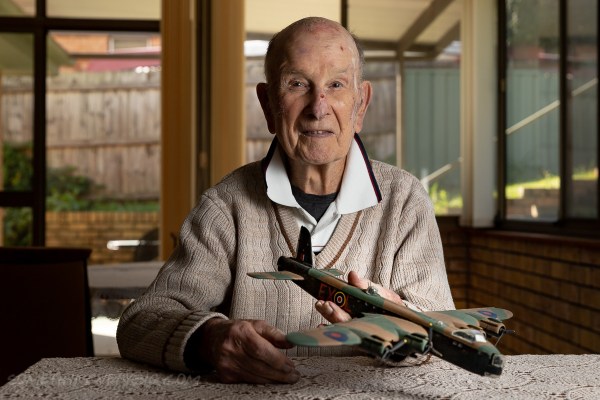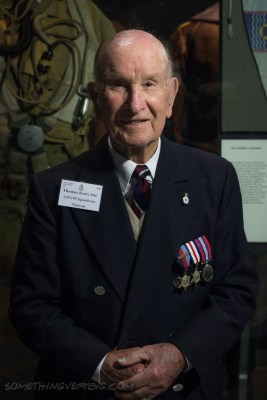Between 2015 and 2017, I interviewed 27 Bomber Command veterans as part of the International Bomber Command Centre’s Digital Archive project. There were nine pilots, seven navigators, four wireless operators, two bomb aimers, one mid-upper gunner, three rear gunners and a WAAF.
All I needed, I noted at the time, was a flight engineer – then I’d have collected an entire bomber crew.
Eighteen months later, I finally managed to rectify that, when I interviewed Tommy Knox: the only Bomber Command flight engineer I’ve ever met.

Tommy died this week in a Sydney hospital at the age of 95.
It took a few years of gentle persuasion from his family to get him to agree to an interview, but in the middle of 2019, I flew to Sydney and drove a hired car out to Tommy’s nice (if slightly weathered) house in the suburbs, dragging with me a soft briefcase with my laptop, voice recorder, camera and assorted photo lighting kit. I walked up a short but steep driveway, and didn’t even have to knock: as I turned up, there was the redoubtable Tommy, already standing at the door. I dragged my several kilograms of gear inside, and we sat down at a small table in the corner of the room. Tommy made us a cup of tea, I turned on my voice recorder, and for the next hour we talked.
We talked about all sorts of things. Growing up in a tenement on the outskirts of Glasgow. The Boys Brigade. Getting an engineering apprenticeship with the railways – a reserved occupation – and realising that the only way out was to volunteer for aircrew. (“And so I did!”). Training at St Athan. Flying in his beloved Stirling bomber. Operations with 149 Squadron: first, coastal mining sorties and the occasional bombing raid on a marshalling yard and then, later, ‘special operations’ to isolated fields in France, dropping supplies for the Maquis. Moving to 199 Squadron for radio counter-measure operations. Finishing his tour and being posted to the draughting department of a maintenance unit where, as a warrant officer, he outranked his sergeant boss. Standing up on a table, singing, the day the war ended. Becoming a parachute instructor, training paratroops in the Middle East, before demobbing. And the moment he decided, while shovelling snow from his doorway shortly after arriving home again in February 1947, that he’d move to Australia in search of better weather.
Unfortunately the interview that we recorded that day hasn’t yet been properly ingested into the Archive, so it’s not yet publicly available (edit 09NOV20: it is now!). That meant that, before I sat down to write this piece this morning, I had to listen to the interview tape again.

Which meant that I got to hear Tommy’s Glaswegian voice again. His accent was softened by decades on Sydney’s Northern Beaches, but it was still unmistakable. And it meant I got to hear the little asides and comments that were always delivered with sparkling eyes, and hear the little ‘ha-ha’ that he used when he was talking about something terrific.
I met Tommy at the annual Bomber Command weekend in Canberra in 2011. Probably my favourite memory of Tommy comes from the same event the following year, when on the Saturday night after the official cocktail party ended, I was sitting at the bar at the hotel with Tommy on one side and the much-missed Don Huxtable on the other as they shared some flying stories late into the evening.
We wrote to each other, too. Until I pulled the letters out again this morning, I’d forgotten about how rich a correspondence we enjoyed: there’s one brilliant letter, for example, that told me in more detail than I ever expected I’d need, exactly how the Stirling fuel system worked. In another, there’s a wonderful description of Tommy’s 2012 trip to the UK for the opening of the Bomber Command memorial in London. In yet another he told me about how, as a flight engineer, he was fully qualified on the Stirling before he’d even been airborne in one.

There is of course an intense (if mostly tongue-in-cheek) rivalry among Bomber Command types over whose was the best aeroplane. Naturally, your allegiances lie with the type you flew on operations: Lancaster men know they had the superior machine. Halifax men always seem just a little bit defensive about their aircraft, and like to emphasise how much easier it was to get out of a Halifax in an emergency than it was a Lancaster.

And Stirling men? Well, I’ve met precious few of them, but if Tommy is anything to go by, there was nothing but an immense pride in his aeroplane. Unlike most aircrew, Tommy got to choose, while training at St Athan, what aeroplane he wanted to specialise in. “I picked the Stirling,” he told me. “I saw this picture of [one] – I’d never seen [a real] one before: big, beautiful, Clyde-built. I thought that’ll do me.” And it did, through no fewer than forty operational flights. Sparse notes in his logbook show that along the way they safely negotiated several flak holes, a burst tyre (with associated ground loop on landing), a flap failure and an undercarriage failure (Tommy had to wind it up and down by hand). “[The Stirling] wasn’t pretty,” he said, “but it was big and strong, like a battleship.”
Tommy moved to Australia in 1950. First he settled in Queensland, but after a while he met his wife and, as she was a Sydney girl, they soon moved south. Tommy kept his engineering interest all his life, working as a mechanic fixing things as diverse as washing machines, lawn mowers, petrol bowsers and, somewhat incongruously, perhaps, Xerox copy machines. He lived in the same house in Northern Beaches from 1986 until only a very short time before he died.
“I’ve had a pretty good life,” Tommy said when our interview was winding up. “Pretty good, yeah.”
I don’t think there’s anyone who would disagree with that. He’ll be badly missed.

© 2020 Adam Purcell
